|
Disney's Blue Ribbon Pop-Up Books - Exploring the Magic of Their Global Editionsl
"Copyright © Vintagepopupbooks.com. All rights reserved. This content may be cited with proper attribution to Vintagepopupbooks.com and a link back to the original source."
A wealth of knowledge exists concerning the Blue Ribbon Disney pop-up books, yet
details regarding their international publishers remain sparse. We'll commence
with an overview of the American Disney pop-up editions by Blue Ribbon Press,
subsequently delving into the finer points uncovered by our investigation into
the editions published abroad.
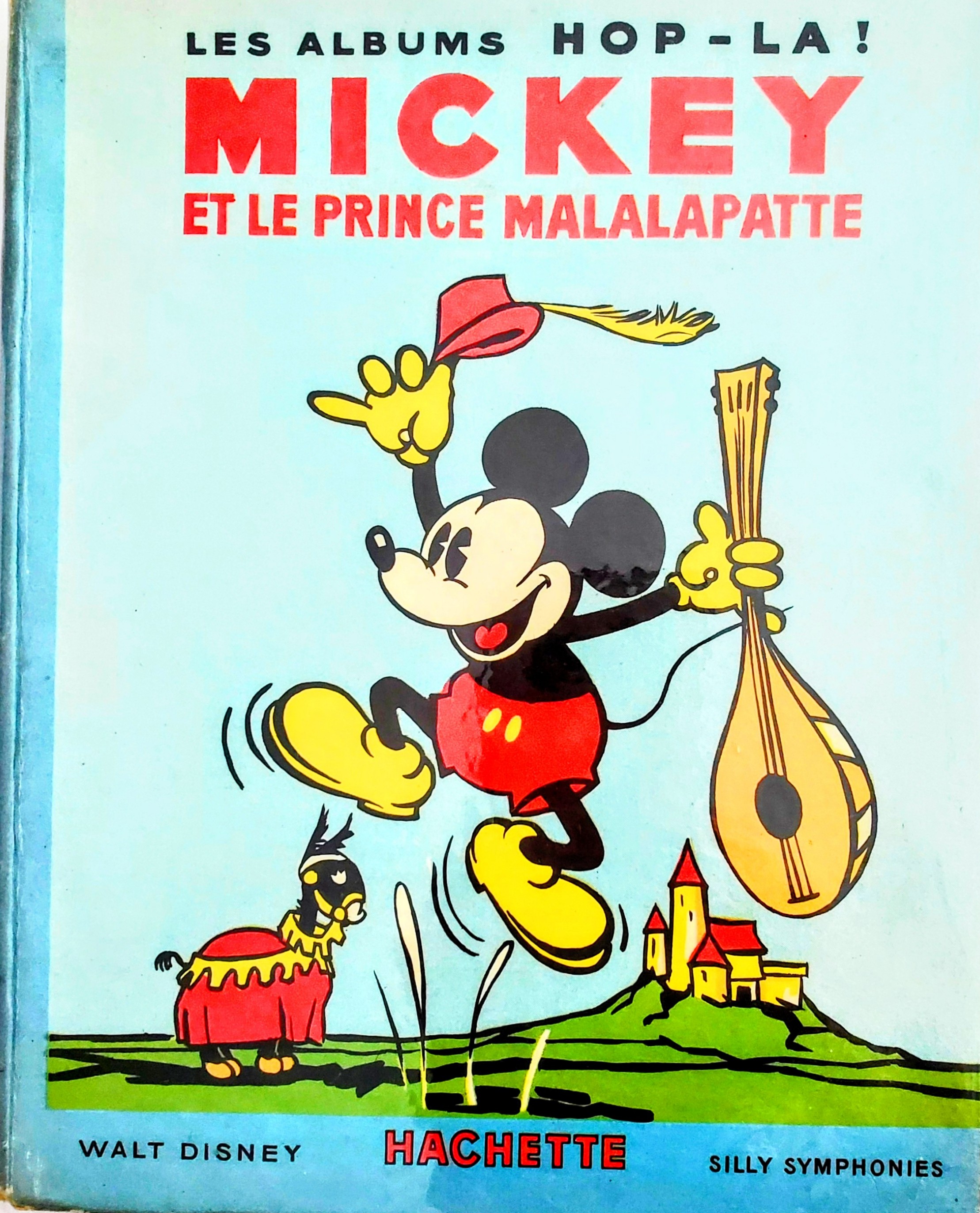 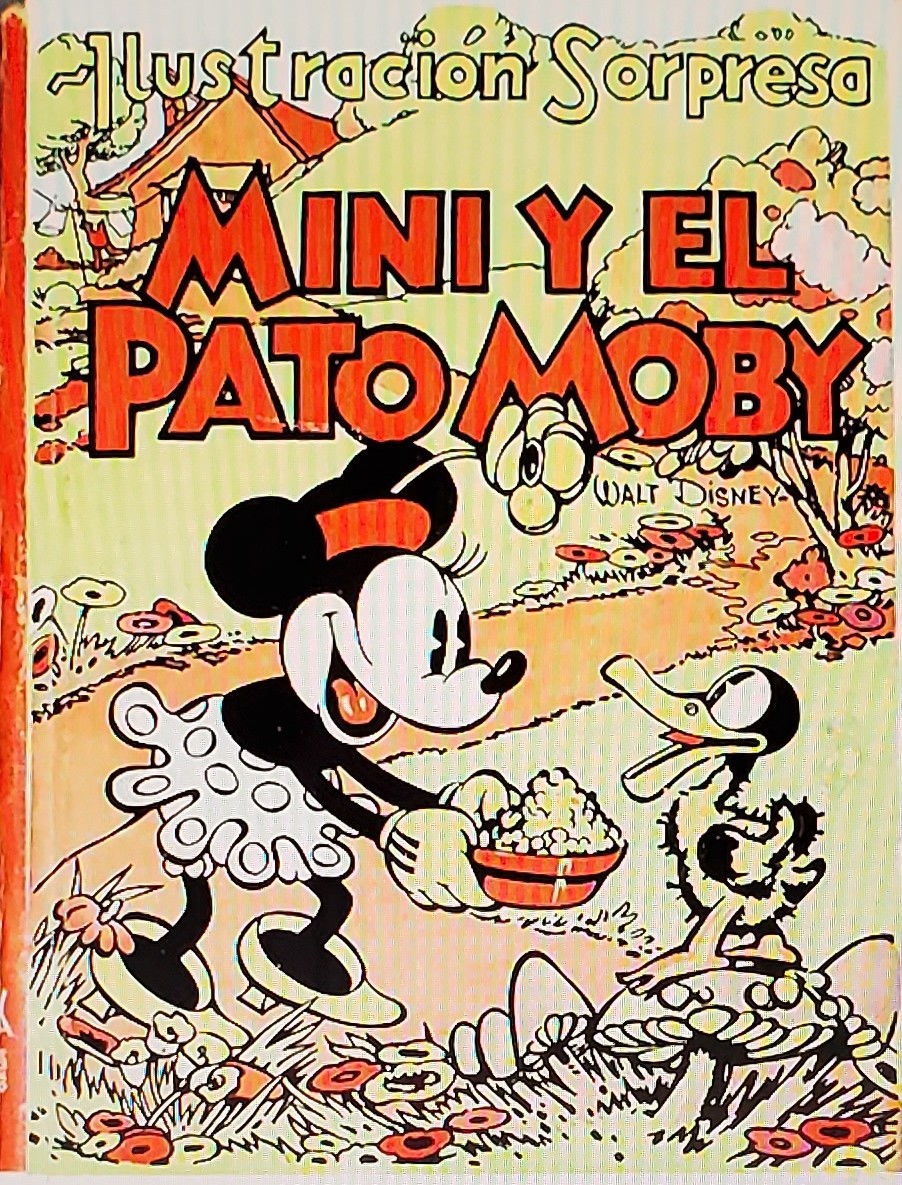 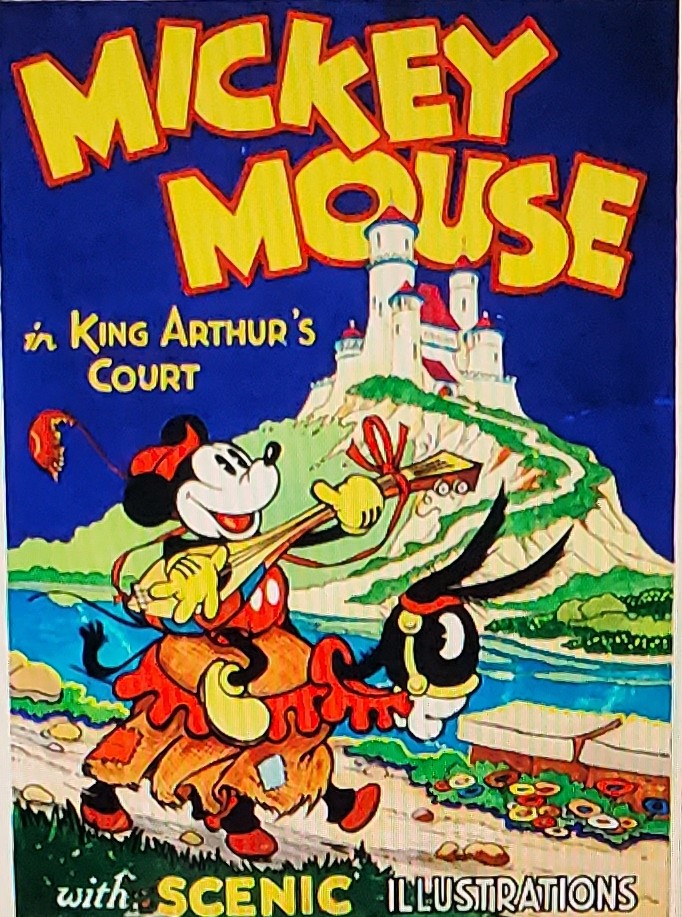 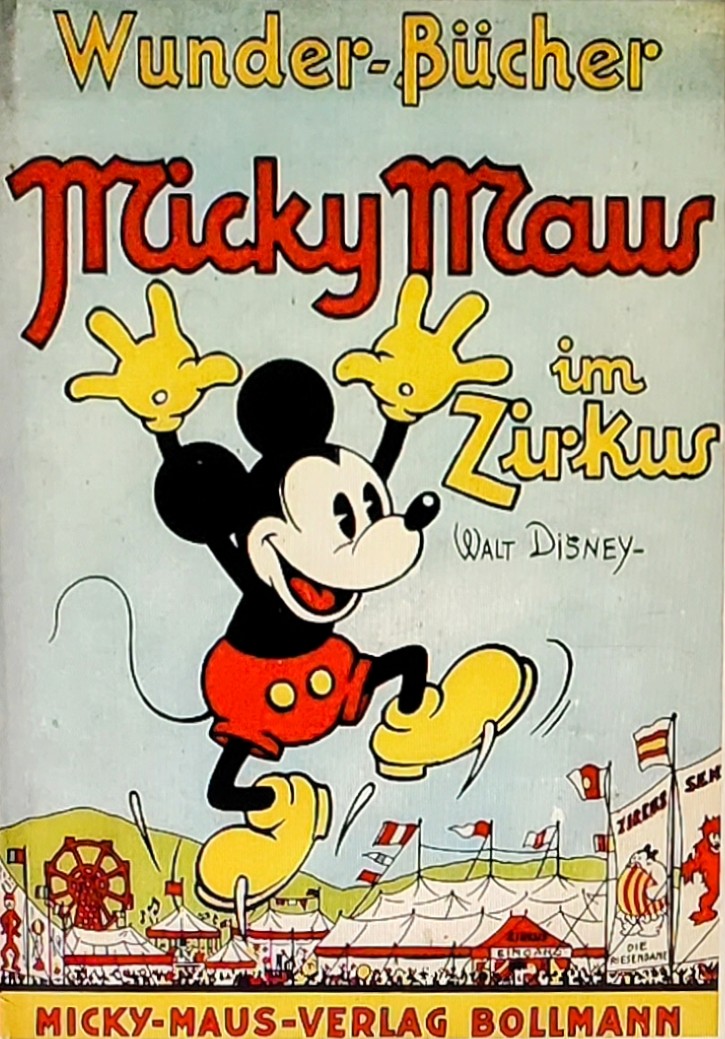 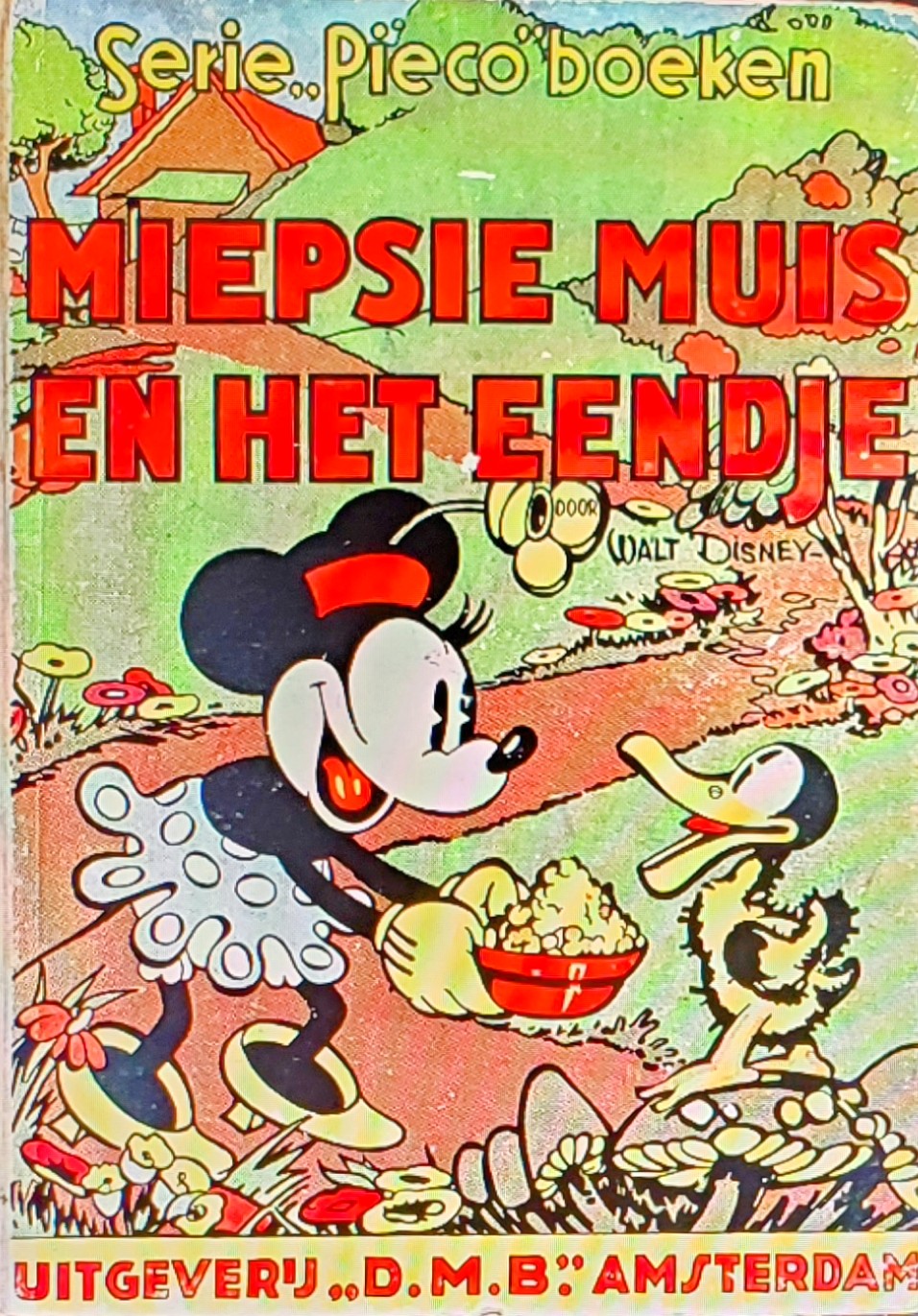
American Editions:
The publishing company Blue Ribbon Books, Inc., established in 1930 was located at 386 Fourth Avenue in New York City. It began as a joint venture specializing in non-fiction reprints. It was co-owned by Dodd, Mead, Harper, Harcourt, and Little, Brown. It was later acquired by Eugene S. R. Reynal, [1902 - 1968] of Reynal &
Hitchcock in 1933. Reynal, an influential American publisher, led the company
until 1939, notably overseeing the production of Disney pop-up books. In 1934
Blue Ribbon Publishing in New York during the 1930’s was known for producing a
series of imaginative pop-up books during this time, and many of the books
featured characters inspired by the growing popularity of Walt Disney
animations. In the United States Blue Ribbon
published 6 Disney pop-up books, four in 1933 and two in 1934. The paper engineer
responsible for the Disney pop-up books published by Blue Ribbon Books in the
1930s was Harold Lentz. . Blue Ribbon was notably the first publisher to use
the term "pop-up" to market their books. patent
nº 1,913,797 "Pop-up".
In 1932, Reynal dubbed these books "Pop-Ups," investing $20,000 in two titles and facing the challenge of selling them within a two-month period before Christmas. The new "Pop-Ups" made their debut in U.S. bookstores amidst significant excitement and media attention. This release was preceded by an extraordinary advertising campaign, setting the stage for their publication. The Pop-Ups achieved remarkable success, securing the top spot on the juvenile bestseller list in both November and December. The initial titles released in 1932 were "Jack the Giant Killer" and "Pinocchio." Each book was made available for purchase at a price of $2.00 starting on October 15, 1932. Blue Ribbon Books announced that due to challenges in the manufacturing process, each title would only undergo a single print run.
Due to the overwhelming success of the initial Pop-Ups, Blue Ribbon revealed in May 1933 their plans to publish four new titles. Reynal successfully convinced Walt Disney to include Mickey Mouse in the Blue Ribbon series. Eugene announced that the term 'Pop-Ups' had been officially registered as a trademark, providing full legal protection for its exclusive use under this name. Subsequent pop-up books would have varying and lower price points. )For example, Pop-up Mickey Mouse and Pop-up Minnie Mouse sold for 75c. "Mickey Mouse in King Arthur's Court" and "Pop-up Silly Symphonies" were priced at $1.75 each. Additionally, four new titles, each priced at 50 cents, were released: "Sleeping Beauty," "Jack the Giant Killer," "Little Red Riding Hood," and "Jack and the Beanstalk." Note that by October 1933, Blue Ribbon found it necessary to announce price increases for the Pop-Ups.
In 1934, Sam Gold established
his mark in the publishing industry by producing a pop-up book featuring
well-known comic characters for Blue Ribbon Books. Notably, he was responsible
for the creative development, marketing strategy, and engineering of the
books through his East Coast-based company, Sam Gold Novelty Company. He
secured the character licensing through negotiations with his connections,
including Al Leowenthal of the Famous Artists Syndicate and John Dille for the
Buck Rogers pop-up book. The lineup included characters like Tarzan, Orphan
Annie, and others, with Sam also crafting the promotional display stand. This display was a marketing tool employed by prominent stores like Bloomingdales, Gimbel Brothers, J.L Hudson, R.H Macy, Marshall Field, and John Wanamaker to promote Blue Ribbon Pop-Up Books. The display was a three-dimensional cardboard structure measuring 11x12.5 inches in height and 11.75 inches in depth. Designed specifically for showcasing Blue Ribbon Pop-Up Books, the back of the display featured the phrase "Open the book and watch the pictures pop-up." It was typically used to hold a book, often opened to a page featuring one of the middle pop-ups to attract attention. Notably, in 2018, Hakes Auction House sold one of these displays for $3,894.00, indicating its value as a highly collectible item.
In July 1934, Blue Ribbon introduced their latest "Revolutionary Idea" - The Mickey Mouse Waddle Book. The Waddle Books were anticipated to be exceptional bestsellers. They combined the essentials of all children's books – a story and colored illustrations – with an innovative feature: three-dimensional characters that could walk without any mechanical assistance. While not called Pop-up these were self-explanatory merchandise that sold themselves on sight. Blue Ribbon produced an initial run of 50,000 copies of the Mickey Waddle, priced at $1.00, and shortly thereafter followed up with The Wizard of Oz Waddle Book, priced at $2.00.
For the 1934 holiday season, three new pop-ups were released: "The 'Pop-up' Mother Goose," "The 'Pop-up' Goldilocks and Little Red Riding Hood," and "The 'Pop-up' Puss in Boots." These brand new pop-ups were remarkably priced at just 20 cents each. Blue Ribbon highlighted that the quality of these books was better than ever, attributing the astonishingly low price to the discovery of new methods for creating Pop-Ups. In December, five titles from The Midget Pop-up Book series were also made available. Each book in this series was compact, measuring 13 cm, and contained 60 pages, featuring one pop-up.
In 1934, Sam Gold established his mark in the publishing industry by producing a pop-up book featuring well-known comic characters for Blue Ribbon Books. Notably, he was responsible for the creative development, marketing strategy, and engineering of the books through his East Coast-based company, Sam Gold Novelty Company. He secured the character licensing through negotiations with his connections, including Al Leowenthal of the Famous Artists Syndicate and John Dille for the Buck Rogers pop-up book. The lineup included characters like Tarzan, Orphan Annie, and others, with Sam also crafting the promotional display stands.
In the fall of 1935, with a sense of optimism brewing among booksellers due to rising sales, Blue Ribbon announced the release of eight new pop-up titles. These included "Tarzan," "Terry and the Pirates," "Tim Tyler," "Flash Gordon," "Popeye," "Buck Rogers," "Little Orphan Annie," and "Dick Tracy," each priced at 25 cents. While these titles were advertised and listed in the Publishers' Trade List Annual as Blue Ribbon titles, the imprint in each book was actually "Pleasure Books, Chicago, Illinois." Some of the books also carried the notation "A Blue Ribbon Press Book." Interestingly, in the 1930s, "Publishers' Weekly" published an annual list of domestic publishers, but Pleasure Books wasn't listed for 1935, suggesting that it was likely an imprint of Blue Ribbon.
The innovation of the Blue Ribbon pop-up books is credited to Cary Cloud, who patented the concept and pitched it to Blue Ribbon Books. Harold Lentz also contributed as an illustrator for these books. Sam Gold's collaboration extended to Disney's leading marketer, Kay Kamen, further solidifying the books' success in the market. C. Carey Cloud, in his 1983 autobiography titled "Cloud Nine: The Dreamer and the Realist," claims the credit for inventing the pop-up mechanism utilized in Blue Ribbon Books' series. Cloud recounts his journey, beginning with the creation of a children's novelty item that failed to impress Sam and Ira Gold of Blue Ribbon Book Publishers. However, his innovative concept of a book that featured a leveraged action image at its center upon opening captivated the Golds' interest. He secured two patents for his pop-up book idea, which led to his initial sketches being enthusiastically received by Blue Ribbon Publishers, sparking a demand for multiple books. Producing these books was an intense endeavor, demanding sixteen-hour days to keep on track with the aggressive publishing schedule. In a single year, Cloud delivered seventeen books, transforming the entirety of Mother Goose's characters into pop-up figures and extending his innovation to include renowned characters from the world of comic strips.
What happened to Blue Ribbon books?
Reynal, who also founded Reynal & Hitchcock, managed Blue Ribbon Books until 1939 when it was sold to Doubleday. During its operation under Doubleday from 1939 to 1949, Blue Ribbon Books continued to publish reprints from various publishers' back catalogs.
Blue Ribbon Pop-up Books 1930’s:
1933:
Jack and the Beanstalk - Blue Ribbon Books, 1933. Jack the Giant Killer - Blue Ribbon Books, 1933. Little Red Riding Hood - Blue Ribbon Books, 1933. Mickey Mouse in King Arthur's Court - Blue Ribbon Books, 1933. The "Pop-up" Minnie Mouse - Blue Ribbon Books, 1933. The Pop-up Mother Goose - Blue Ribbon, 1933. Sleeping Beauty - Blue Ribbon Books, 1933. The "Pop-up" Silly Symphonies - Blue Ribbon Books, 1933.
1934:
The Tale of Peter Rabbit - The Midget Pop-up Book, Blue Ribbon Books, 1934. The Story of Little Black Sambo - The Midget Pop-up Book, Blue Ribbon Books, 1934. Mickey Mouse in "Ye Olden Days" - The Midget Pop-up Book, Blue Ribbon Books, 1934. Popeye Among the White Savages - The Midget Pop-up Book, Blue Ribbon Books, 1934. The Wizard of Oz Waddle Book - Blue Ribbon, 1934. Goldilocks and the Three Bears - Blue Ribbon Books, 1934. Puss in Boots - Blue Ribbon Books, 1934. The Mickey Mouse Waddle Book - Blue Ribbon, 1934. Buck Rogers in the Dangerous Mission - The Midget Pop-up Book, Blue Ribbon Books, 1934. The "Pop-up" Pinocchio - Blue Ribbon Books, 1934. The "Pop-up" Mother Goose - Blue Ribbon Books, 1934.
1935:
Dick Tracy: The Capture of Boris Arson - Pleasure Books, 1935. Flash Gordon: The Tournament of Death - Pleasure Books, 1935. Popeye with the Hag of the Seven Seas - Pleasure Books, 1935. The New Adventures of Tarzan "Pop-up" - Pleasure Books, 1935. The Pop-up Little Orphan Annie and Jumbo, the Circus Elephant - Pleasure Books, 1935. Terry and the Pirates in Shipwrecked - Pleasure Books, 1935. Tim Tyler in the Jungle - Pleasure Books, 1935. Buck Rogers, 25th Century featuring Buddy and Allura in "Strange Adventures in the Spider Ship" - Pleasure Books, [1935].
American (Blue Ribbon) references:
Movable Book Society. (2004, May). Movable Stationery, 12(2). The Movable Book Society.
Montanaro, Ann. "Blue Ribbon Pop-ups." Movable Stationery, vol. 4, no. 3, September 1996
"Articles and Advertising." Publishers' Weekly, issues from 1932 through 1936.
Find a Grave. (n.d.). Eugene Sugny Reynal. Retrieved January 18, 2024, from Find a Grave website.
The International editions:
International Editions of Disney Blue Ribbon Books (New York, USA, acquired by Reynal & Hitchcock in 1933) are fun to collect as they sometimes have different scenes and all have an absence of the trademark word "Pop-up" Some were larger. For more information on the international editions, Theo Gielen had an interesting article about them in Moveable Stationary, vol. 8, no. 2, May 2000, p. 1. We have attempted to build on that with a deeper dive and to look into the publisher's history as well as how they established their relationship with Disney.
The production and distribution of foreign editions of Disney pop-up books were likely a collaborative effort involving both the Walt Disney Company and the respective local publishers in each country, rather than by Blue Ribbon Books. One reason to suspect this is because Blue Ribbon had trademarked the term “pop-up” which the foreign editions did not use.
French editions published by Hachette: (Les Albums Hop-La
UK editions published by Dean & Son: (Scenic illustrations)
Spanish editions* published by Molino: (Ilustración Sorpresa)
Italian editions published by Mondadori: (Illustrazioni a sorpresa)
German/Swiss editions published by Bollmann: ( Wunder-Bucher)
Dutch editions published by Uitgave D.M.: (Serie Pieco boeken)
United Kingdom:
Books are under the Dean & Son imprint and use the words “Scenic Illustrations” rather than pop-ups. The main publisher, however, was Odhams Press. Dean at that time was their Children’s Book subsidiary. Odhams Press was a British publishing company. Founded in 1890, it took the name Odhams Press Ltd in 1920. They ceased publishing in 1969 when they were sold to Fleetway/Mirror Co.
In September of 1921, the brothers and Dean & Son Limited were bought out by Odham’s Press for the sum of £ 456,316. Odham’s continued the Dean & Son imprint and moved its company to a fine building that they remodeled for their purposes at 29 King Street Covent Garden. In 1933 the company moved to No. 6, La Belle Sauvage, Ludgate Hill London. It is interesting to note that in the 1921 newspaper announcement for the buy-out of Dean & Son, the managing director of Odham’s Press, J. S. Elias, stated that Dean & Son had been family-owned since 1702, in the days of Queen Anne. He went on to say that he would continue to run the business under its present style and traditions but that big developments could be anticipated. Under Odham’s and the imprint Dean & Son LTD, Dean & Son went on to produce the 1930’s UK versions of two of Blue Ribbon Books pop-up books.
Starting in 1936, they also published the "Mickey Mouse Weekly" comic. Odhams also published The Mickey Mouse Annual under the Dean & son imprint, they published 18 editions between 1930 and 1947.
It is assumed but not proven that Wilfred Haughton also illustrated the “Scenic Illustrations” UK pop-up books. This theory became more accepted in 2012 when material from the artist's archive was shown at the Dominic Winter Book Auctions, held June 2 that year. The archive included a Haughton sketchbook (1930s) of pop-up and movable designs. In the the mid-1940's Haughton was fired from Odham’s for refusing to bring his illustrations of Mickey and his friends into line with the modernized style of Disney Studios. Eventually, Odhams lost the rights to the Disney characters in 1957 because of a copyright dispute with Disney.
More about the history of Odham’s Press : . Odhams Press, operational from 1920 to 1968, started as a British magazine publisher before branching into book publishing and children's comics. The roots of Odhams Publishing trace back to 1847, beginning with Biggar and Odhams in Burleigh Street, London, and evolving into William Odhams Limited. In 1893, the business was sold by William Odhams to his sons. They continued the family legacy in Burleigh Street and expanded by setting up Odhams Brothers Limited at Hart Street, Covent Garden, marking a significant development in the company's history.
By 1898, the various branches of the business consolidated into Odhams Limited. In 1905, the company relocated to Long Acre, WC2. The transition to Odhams Press Ltd occurred in 1920, aligning with its merger with John Bull Ltd, known for its highly circulated mass-market magazine produced by Odhams. Under the direction of Julius Salter Elias, later known as Viscount Southwood and eventually Lord Southwood (1873 – 1946), the company experienced remarkable growth. Lord Southwood revolutionized the printing industry in the 1920s by introducing the rotogravure system, which enabled high-speed, four-color printing, essential for mass magazine production. In 1935, Odhams (Watford) Limited was formed, and its main facility was completed in 1936, marking another significant milestone in the company's expansion.
During the 1930s, Odham's Press, led by Chairman Lord Southwood (Mr. J. S. Elias), played a crucial role in popularizing Disney characters in the United Kingdom. Under their imprint, Dean & Son LTD, they produced prominent pop-up books in collaboration with Walt Disney, such as "Mickey Mouse Presents his Silly Symphonies" and "Mickey Mouse in King Arthur's Court." A key aspect of Odham’s relationship with Disney was the publication of "Mickey Mouse Weekly," a publication that introduced and popularized Disney's characters and stories in the UK. It uniquely combined American Disney reprints with original British Disney content and other non-Disney strips. This partnership was instrumental in broadening Disney's influence in the British market during this era. However, by 1957, Odhams lost the rights to the Disney characters, marking the end of this influential collaboration.
n 1959-1960, Odhams acquired Hulton Press, renaming it Longacre Press, and took over the publication of several children's comics like "Eagle" and "Girl." The company was acquired by Fleetway Publications in 1961, and then by International Publishing Corporation (IPC) in 1963. In 1968, Odhams Press faced financial challenges due to Britain's economic conditions. This, combined with the International Publishing Corporation's (IPC) strategy to streamline and reduce redundancy, led to the closure or transfer of Odhams' comic titles to IPC Magazines Ltd As a result, Odhams Press, functioning as an independent entity with its own financial responsibilities, became economically unsustainable. Consequently, by January 1, 1969, Odhams Press ceased operations as a publishing business. Dean & Son continues to operate as a private company under Egmont, focusing on children's publishing.
UK editions of Blue Ribbon Books: ( Produced with the permission of Mr Walter E Disney )
Mickey Mouse in King Arthur’s Court: With “Scenic” Illustrations. London, Dean & Son, Ltd., 1934.Description: 41 pages. 25 cm. “Story and illustrations by the staff of the Walt Disney Studios.”Same content as the Blue Ribbon edition.
Mickey Mouse Presents his Silly Symphonies: Babes in the Woods: King Neptune: With “Scenic” Illustrations. London, Dean & Son, Ltd., n.d. [193-?].Description: 18 x 24 cm. 48 thick pages. 4 pop-ups.
References:
Hunt, P. (2013). International Companion Encyclopaedia of Children's Literature. Routledge. p. 245. Becattini, A. (2016). Disney Comics: The Whole Story. Theme Park Press. p. 148. Movable Stationery. (n.d.). Volume 20, Number 3, Page 13. Odham's purchase off Dean 7 son in 1921: The Saturday Review of Politics, Literature, Science, Art, and Finance, Volume 136 Saturday Review, Limited, 1923 - Literary and political reviews page 29
Spanish versions of Blue Ribbon Pop-up Books were published by Molino: (Ilustración Sorpresa) registered in Spain with Modelo de utilidad nº 2,529 “Ilustración Sorpresa”
Note that Spain was the first country to publish a translation, it was done by Alfonso Nadal. Molino later also sold the pop-ups in the South American market.
The Molino Publishing House, Founded in 1933 by Pablo del Molino Mateus (1900-1968), after Molino split from the Juventud Publishing House (from which Pau Molino Mateus left by selling all his shares to Josep Zendrera) Editorial Molino was established to offer accessible novels to the public. Starting as the deputy director of Juventud, Molino Mateus ventured into publishing popular genres like detective and adventure stories.. They were located at Editorial Molino headquarters in Carrer Calabria 166, Barcelona, Spain.
i I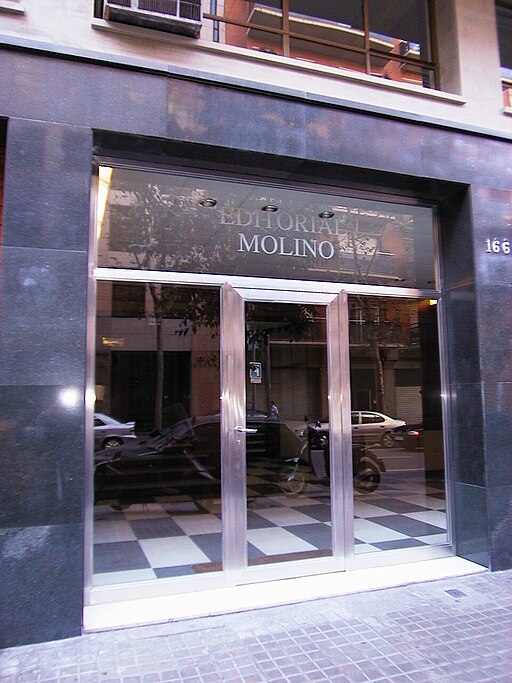 Editorial Molino headquarters built in 1933 Attributed to Jordi Nyol, CC BY-SA 3.0, via Wikimedia CommonsMolino also started Mickey magazine, which popularized American comics in Spain and gathered a large readership. Known for pioneering pop-up books in Spain, Molino Mateus led the company until 1937 before moving to Argentina, leaving his brother Louis del Molino (from Valladolid) in charge. In 1947, Luis del Molino officially became a partner with 45% of the company's shares (55% remaining for Pablo del Molino). After Pablo's return in 1952, he revitalized the company's publishing direction..
Molino's editorial work with Disney consisted of translating the texts and faithfully reproducing the American illustrations and pop-ups markets. From 1934, until the end of the Spanish Civil War in 1939, the Molino publishing house published numerous titles including the Disney pop-up books listed below.To be specific, he pop-ups that were published following the American model were El ratón Mickey en la corte del rey Arturo, Los enanos del bosque y el rey Neptuno , El ratón Mickey en el circo and Mini y el Pato Moby the year 1934 and El Gallito del lugar (1938). (most had some color variations from the BRB versions on the covers, however).
Other pop-ups published by Editorial Molino were Harold B. Lentz's La tia Ansaronav, Puss in Boots (1936), and KC Segar's Popeye and the Witch of the Seven Seas (1938). Note that Molino also adapted these books for the South American market later on.
At least the first - The Spanish version of "Mickey Mouse in King Arthur's Court" - was translated by Alfonso Nadal and released in 1934. It was registered in Spain under the Utility Model number 2,529 as "Illustration Surprise" and in the United States under patent number 1,913,797 as "Pop-up." Note that Molino lost the rights to edit the works of Walt Disney in 1939 and would not publish them again until the 1970s. They did however resume publishing other Ilustración Sorpresa pop-up book titles in the 1940’s that were not connected to Disney or Blue Ribbon Books. Editorial Molino, known for introducing the "Ilustración Sorpresa" (pop-up book) in Spain in 1935, continued publishing these books even after losing the rights to Walt Disney's works. During the 1940s, they produced a variety of non-Disney titles under the "Ilustración Sorpresa" series. This series included classic tales and other themes, with books such as "POPEYE Y LA BRUJA DE LOS SIETE MARES" (1938), "EL GALLITO DEL LUGAR" (1938), "LA TÍA ANSARONA" (1939), "EL GATO CON BOTAS," "LA GALLINITA DE LOS HUEVOS DE ORO," "LA BELLA DURMIENTE," and "SIMBAD EL MARINO."
Molino’s children, Maruja del Molino and Fernado Peraire del Molino in the marketing image below, are shown in 1934 enjoying their Dad’s publication "Ilustracion Sorpresa") "El Ratón Mickey en el circo" ("Mickey Mouse in the circus")
(Image attributed to Lluis serra, CC BY-SA 4.0 <https://creativecommons.org/licenses/by-sa/4.0>, via Wikimedia Commons)
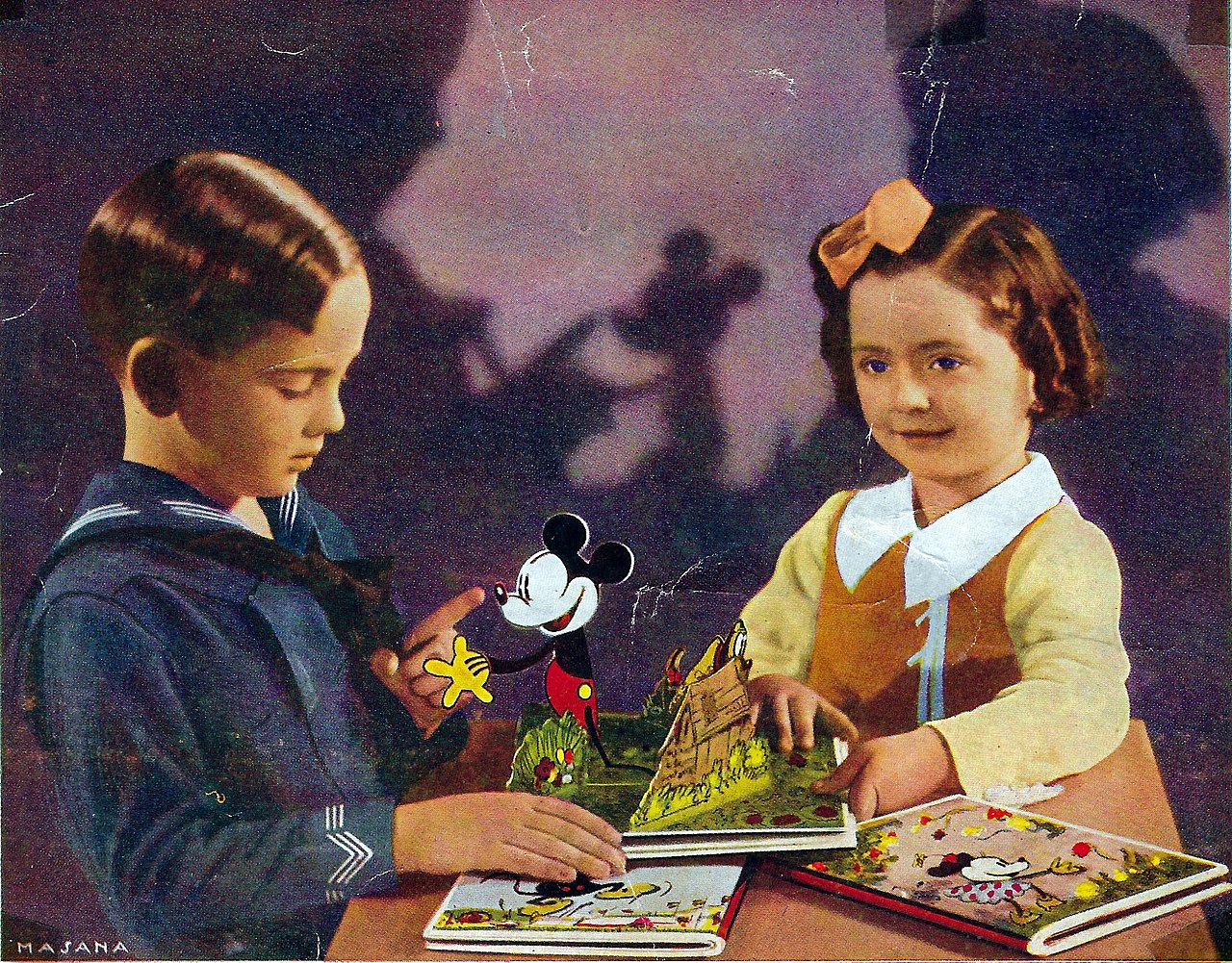
It is also interesting that while Molino was the initiator of the publication of toy books in Spain, it was not the only one. After its success, the publisher Juventud, from which Molino had split, began publishing in 1935, a series of pop-up style books called Animated Stories, in Spanish and Catalan. The success of these pop-ups caused that in 1935 Editorial Juventut, from which Molino had become independent, tried to imitate them by creating pop-ups that were not very successful despite their special accordion binding, as was the story of Peter Pan (in Catalan and Spanish versions).
The popularity of pop-up books led Editorial Juventud, from which Molino had separated, to attempt replicating their success in 1935.Juventusd began publishing in 1935, a series of pop-up style books called Animated Stories, in Spanish and Catalan They produced pop-up books with a unique accordion binding, including a version of Peter Pan in both Catalan and Spanish, but these did not achieve notable success.
Following the war, Editorial Molino lost the rights to publish Walt Disney-themed books and was unable to resume until the 1970s. Nevertheless, the publishing house became known for its expertise in creating pop-up children’s books, such as M. Vallbé’s "El Tesoro de Kaleo" (1952) with illustrations by Lozano Olivares, and another on "Sleeping Beauty." The pop-up series retained the name "Illustration Surprise," hearkening back to the label used for the short stories released with pop-ups before and during the Civil War.
Where is Molino today?
In 1947, Luis del Molino became an official partner in Editorial Molino alongside Pablo del Molino Mateus. In 1962 the Publishing House moved to 166 Calabria Street, with its own building and warehouses. After Pablo's death in 1968, his son Pablo del Molino Sterna (1937-2000) took over the company until his own death in 2000. Subsequently, Luis del Molino's son, Luis Antonio del Molino Jover, assumed leadership. During this time, the heirs of Pablo del Molino considered selling the company. Eventually, In June 2004, the RBA Group (Barcelona) bought Editorial Molino and integrated the publications of Editorial Molino as RBA Molino, the publishing imprint of the RBA Group. In May 2021, Penguin Random House Grupo Editorial acquired Editorial Molino from the RBA group. , maintaining its focus on young adult literature.
Spanish editions:
Illustrated by Disney and following the American models exactly except for translation into Spanish and pubisher info
1. "D’El ratón Mickey en la corte del rey Arturo" (Mickey Mouse in the Court of King Arthur) - Translated by Alfonso Nadal, published in 1934. quarto format (26 x 20 cm.) Published in two editions 2. "Los enanos del bosque y el rey Neptuno" (The Dwarves of the Forest and King Neptune) - 3. "El ratón Mickey en el circo" (Mickey In The Circus) - By Walt Disney, translated by Alfonso Nadal, published by Molino in 1934. 4. "Mini y el Pato Moby" (Mickey Mouse at the Circus and Mini and the Duck Moby) - Published in 1934. 5. "Mickey Presenta: Gallito del lugar" (Mickey presents the Little Cock Of The Farm) - Published only in Spain in 1938. 6. Mickey en las carreras Carreras Libro Juguette ( Mickey Mouse waddle Book identical to the American edition except for the translated text)
Other Molino pop-ups not illustrated by Disney but Harold Lentz include:
1. "La tia Ansaronav" La tia Ansaronav, El gato con botas (1936 - Harold Lentz 2. "El gato con botas" (Puss in Boots) - Published in 1936, featuring 3 pop-ups. – Harold Lentz
Illustrated by KC SEGAR:
1. "Popeye y la bruja de los Siete Mares" (Popeye and the Witch of the Seven Seas) - Published in 1938.
Spanish advertisement shown below highlights the "Los cuentos Ilustración-Sorpresa de la Editorial Molino," which translates to "The Surprise-Illustration Stories from Molino Publishing." The text below the title lists various published titles, which include works attributed to Walt Disney, Harold B. Lentz, and E.C. Segar, featuring popular characters like Mickey Mouse and Popeye. The passage describes the books as a treasure that awakens envy among friends and inspires fantastic dreams when they go to bed with it under their pillow.
The ad lists several Disney pop-up books published by Editorial Molino, which include titles such as "El Raton Mickey En La Corte Del Rey Arturo" (Mickey Mouse in King Arthur's Court), "Los Enanos Del Bosque Y El Rey Neptuno" (The Dwarfs of the Forest and King Neptune), "El Raton Mickey En El Circo" (Mickey Mouse at the Circus), "Mini El Pato Moby" (Minnie and Moby Duck), and "El Gallito Del Lugar" (The Little Rooster of the Place). Image from the collection of vintagepopupbooks.com
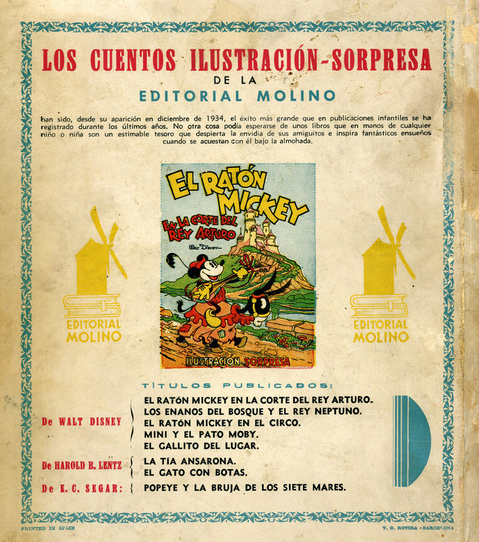
Spanish References:
DEPARTMENT DOCTORAL PROGRAM: DESIGN AND COMMUNICATION: NEW FUNDAMENTALS. DOCTORAL THESIS: THE BOOK AS A TOY, 51 & 52 (In Spanish) MARTA'S SOCIAL SCIENCES “The social science blog in early childhood and primary education” 1960 Author: C.E Eckersley (In Spanish) OROMINAS, QUIM. Pop Up. Movable and three-dimensional books. Girona, Caixa de Girona, 1999 Bellido, Jose and Bowrey, Kathy (2017) Disney in Spain (1930–1935). Business History, 60 (8). pp. 1277-1307. ISSN 0007-6791.
German and Swiss Editions (in the German language)
7 Disney books were published under the name from the Swiss publisher Bollmann in 1936 and 1937.
Established in 1880, Jacques Bollmann AG, a book printing business, was situated on Unterer Mühlesteg in Zurich (located between the present-day Mühlesteg and Bahnhofbrücke). In the 1930s, the company was overseen by siblings Emma Regina Bollmann and her brother Ernst Bollmann During a stay in Italy Ernst Bollman saw the magazine Topolino, which printed Disney comics. He decided to Germanize the comic stories and market them in Germany and Switzerland. In 1936, the Zurich publishing house Bollmann acquired the main license in Paris from the European representative of the Disney publishing house and the sub-licenses in Italy from Mondadori, who at that time published the comics under the name "Topolino" In 1936, following the acquisition of the Disney material rights, the Bollmann siblings established Mickey Mouse Publishing Bollmann. They focused first on the pop-up books,. Martha Ehrat-Bollmann was responsible for translating the texts from English. They were also translated from Italian by Hans Schenk. The German-language Disney pop-up books contained more illustrations and text than the American versions, they were priced between 1.65 and 7 Swiss francs (equivalent to about 55 francs in current value), the books' high cost likely led to lackluster sales.
At the time, Before World War II, Germany was the only prominent European nation without a localized Disney publication, largely due to Adolf Hitler's ascension to power in January 1933. However, a German-language Disney magazine did emerge from Switzerland. The Zurich-based publisher Bollmann released the German-language Disney magazine -"Micky Maus Zeitung" starting in December 1936, with its inaugural issue 0, and continued the publication for 19 issues until September 1937, concluding with issue number 18. Both the Mickey Mouse newspaper and pop-up books published by the Bollmanns turned out to be financial failures. The constraints of Disney's licensing terms, coupled with a challenging economic climate, hindered their ability to generate significant profits.
The Swiss publisher Bollman, had the license to distribute the Disney products in German to all the German-speaking countries. Bollman acquired the main license in Paris in 1936 from the European representative of the Disney publishing house and in Italy from Mondadori
The books were printed in Zurich, Switzerland. Josy Priems, a good friend of the Bollmanns, translated the stories into German from Italian. The publisher Ernst Bollmann had to buy expensive licenses. This in turn made the books more expensive (From 1.50 up to 5.00 Swiss francs each) The project failed economically and production had to be discontinued after the 7th volume in the series. Bollman attempted to look for buyers* or sub-licensees in the Third Reich and Austria but was unsuccessful.
Note: Bollman ended up selling his Mickey rights license to the now-famous toy maker Steiff company in Giengen. Later on they were able to continue working with Disney and bring Mickey back to Germany..
The Wonder Books were sold in Switzerland but not Germany. Bollman’s were the first Mickey Mouse books published in the German language but undesirable in Germany. Walt Disney characters were officially undesirable as a product of the USA in Nazi Germany at the time, despite the fact that Hitler secretly enjoyed them. Hitler's Minister of Propaganda Joseph Goebbels noted in his diary on December 22, 1937: "I am giving the Führer 18 Mickey Mouse films for Christmas. He is very happy about it. »
Image below: Jacques Bollmann AG book printers, Unterer Mühlesteg, around 1930 Attribution: Zentralbibliothek Zürich, Zürich E1, Niederdorf-Qu., Mühlesteg, unt. I, 4 Lizenz Public Domain Mark, Public domain, via Wikimedia Commons
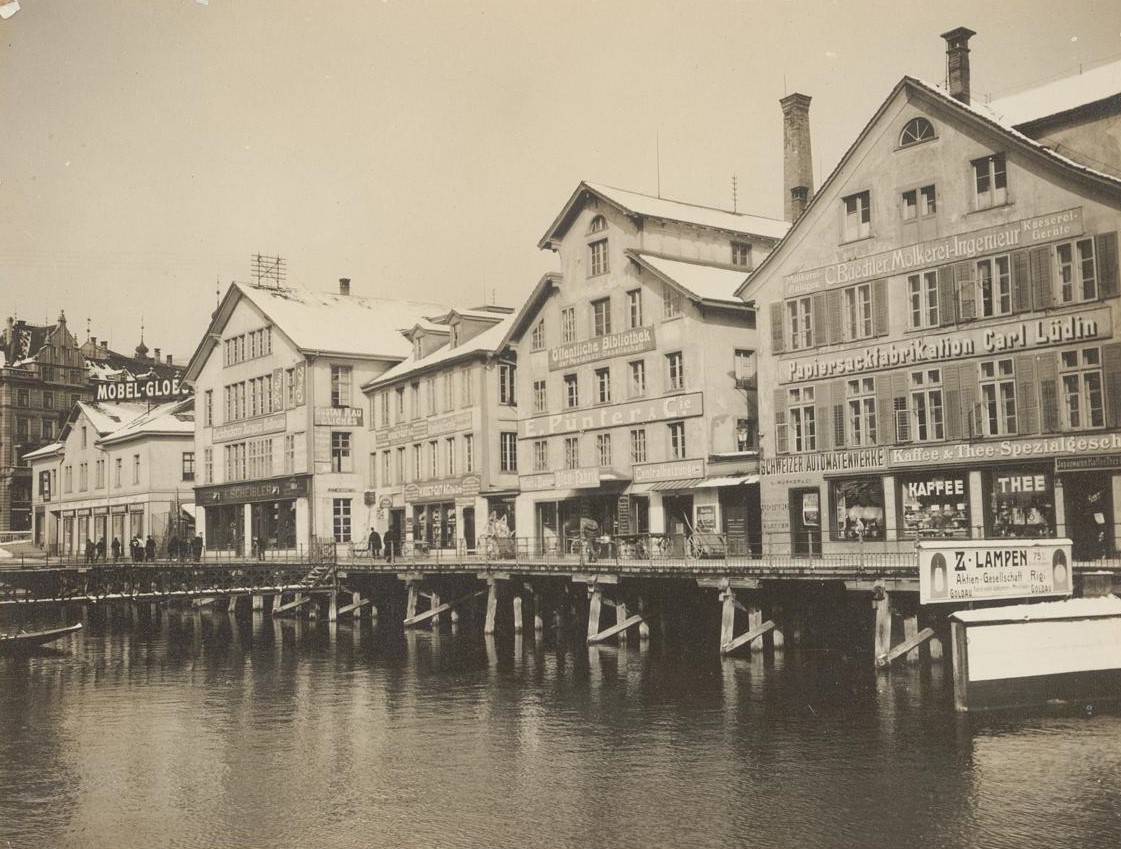
German Language Editions of Blue Ribbon Pop-Up Books Published by Bollmann:
1. Das Lebende Buch der Micky Maus (The Living Book of Mickey Mouse - The Picture Book with the Figures) - Zürich, J. Bollmann AG, 1936. Authored by Hans Schenk. Dimensions: 27 x 21 cm. Notable for being a rare item (a complete copy sold for $12,000 USD in 2018). Original Cost: CHF 5.00.
2. Micky Maus am Hofe König Arthurs (Mickey Mouse at King Arthur's Court) - Zürich, J. Bollmann AG, 1936. Features 4 double-page colored pop-ups, likely designed by Albert Hurter, a Zurich-born Disney animator. Original Cost: CHF 4.00.
3. Die Waldmännlein und König Neptun (The Little Woodmen and King Neptune) - Zürich, J. Bollmann AG, 1936. Includes 4 double-page pop-ups. Original Cost: CHF 4.50.
4. Micky Maus im Zirkus (Mickey Mouse in the Circus) - Zürich, J. Bollmann AG, 1936. Contains 3 color pop-ups and various black-and-white illustrations. Dimensions: 22 cm x 16.5 cm. Original Cost: CHF 3.50.
5. Minni Maus und das Entlein (Minnie Mouse and the Duckling) - Zürich, J. Bollmann AG, 1936. This 30-page book features 3 colored pop-up images and various black/white illustrations. Dimensions: 22.0 cm x 16.5 cm. Original Cost: CHF 3.50.
6. Micky Maus in Afrika (Mickey Mouse in Africa) - Verlag Bollmann, 1936. A 64-page book with some illustrations. Noted for being a Wunder-Bucher without the title on the cover and lacking pop-ups. Original Cost: CHF 1.50.
7. Abenteuer der Micky Maus (Adventure of Mickey Mouse) - Zürich, Micky-Maus Verlag Bollmann, 1936. This 30-page book is illustrated in full color and includes 2 double-page pop-ups. Original Cost: CHF 3.50.
Bollman also published The “Mickey Mouse” newspaper «Micky Maus Zeitung» )mentioned above . 
It cost 25 cents and was published twice a month. It was modeled on the British «Mickey Mouse Weekly», along with «Topolino» in Italy, «Le Journal de Mickey» in France, and «Mickey» from Spain.
About Bolmann’s demise as a Disney publisher: The "Mickey Mouse" newspaper was shuttered in September 1937. In the last issue, No. 18. Bolmann was trying to find a sub-licensee, Micky says goodbye to this last issue as follows: “If this newspaper gets into your hands, I've long been over all mountains. The Scandinavian children high up in the north also wanted a “Mickey Mouse” newspaper and invited me to the opening party. On this trip, I will visit all the other German-speaking countries and look for new friends so that the extensive pictures from my friend Walt Disney's studios can be made more widely available, perhaps in a weekly, more extensive edition of the Mickey Mouse newspaper. Hopefully, I will succeed despite the border closures”
What Happened to the publishing house of Bollman?
Later on, the Bollmann family appeared to move away from publishing and into cartography. After World War II, Hermann Bollmann, likely a relative of Regina and Ernst, sought to document the destruction in Braunschweig, Germany, as part of the rebuilding process. In 1948, he created an aerial-view illustrated map, marking the beginning of Bollmann Maps. The company, known for its meticulous and hand-crafted map-making process, has a catalog of about 100 maps, which they update regularly. Their commitment to quality and craftsmanship in cartography has been recognized and continues to the present day.
German References:
1. "Als Familie Maus im Zürcher Hauptbahnhof eintraf." German Sunday Newspaper, 22 November 1998. 2. Duckipedia and Inducks. "Micky-Maus-Verlag Bollmann." Accessed on 22 January 2020. Available at: Duckipedia. 3. Pro Helvetia. "Comic Country Switzerland." Exhibition Brochure, 4-30 May 2007. Swiss Cultural Foundation Pro Helvetia. 4. Laqua, Carsten. "WIE MICKY UNTER DIE NAZIS FIEL: WALT DISNEY UND DEUTSCHLAND." 1992. (Title translates to "How Mickey Fell Under the Nazis: Walt Disney and Germany"). 5. "Mickey Mouse Newspapers by Bollmann – 1936 and 1937." Disney Fandom. Accessed on 22 January 2020. Available at: Disney Fandom. 11 Corominas, Quim - Book: Corominas, Q. (2008). Paper treasures. Books, games and paper toys. Girona: Caixa de Girona.
FRANCE:
Hachette published “Les Albums Hop-Là” by Walt Disney: 1934-1938 (6 albums); then 1949-1953, according to a new production (7 albums including 1 Babar and 1 Zig et Puce ).
Note: After publishing 6 Disney pop-ups in the 1930’s. It would be 10 years before Hatchette published a second series of Les Albums Hop-La Pop-up books. They were produced between 1949 and 1963. There were 7 titles in the later series, all hardbacks bound in spiral plastic. Each title included 5 animations and was issued with Dust Jackets.
Hachette History: image 1: Louis Christophe François Hachette (1800-1864), ( Adam Salomon, Public domain, via Wikimedia Commons) image 2 - Front of the L Hachette publishing house, passage du Vigan, 14 rue d'Aboukir, 2nd arrondissement, Paris. 1906. 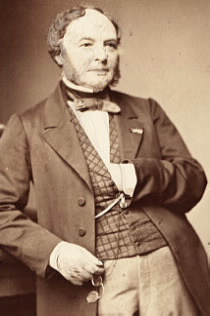 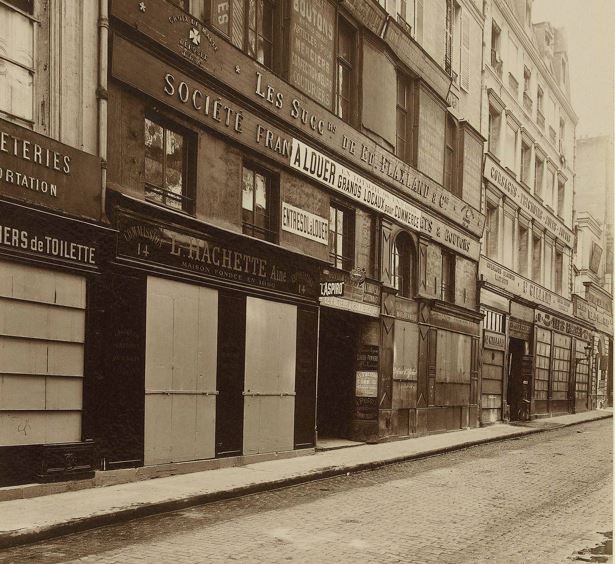
History of ownership:
Louis Hachette, after extensive planning and securing financial support, took over the Parisian bookshop Brédif and the publishing house Librairie de Jacques-Francois Brétif in 1826, which he later renamed to Librairie Louis Hachette. His son-in-law, Louis Breton, joined as a partner in 1840. The company, originally located at 14 rue Pierre-Sarrazin, expanded to 77 boulevard Saint-Germain in 1858. L. Hachette & Company was officially founded in 1846. While it started as a family enterprise, the firm transitioned into a public company, or "société anonyme," in 1919.Ownership in 1849
Ownership percentage for Hachette: Initially, the ownership of the company was equally divided among Louis Hachette, his son-in-law Louis Breton, and another son-in-law, Emile Templier, with each holding a 33.33% stake. In 1857, the ownership structure changed when Alfred Hachette, Louis Hachette's son from his first marriage, joined as a partner. This adjustment resulted in Louis Hachette, Louis Breton, and Emile Templier each owning 29.17% of the company, while Alfred Hachette held a 12.5% stake. Further changes occurred in 1862, just before the death of Louis Hachette, when Georges Hachette, his son from a second marriage, became a partner. This led to a new distribution of shares: Louis Hachette, Louis Breton, and Emile Templier each owned 25%, while Alfred Hachette and Georges Hachette each held 12.5% of the company.
In 1870, Alfred Hachette, the eldest son of Louis Hachette, was facing health issues and had retired to Pau for several years. He sold his share in the company to René Fouret, who was married to Catherine Breton, the daughter of Zélime Auzat, and subsequently became an Associated Bookseller. Louis Hachette passed away in 1864, leaving behind a substantial fortune and a thriving company with 165 employees. By 1878, the company's sales had reached 18 million French Francs. Following his death, the business structure evolved, becoming “Société en Commandite Simple Louis Hachette” in 1872 and later “Société Anonyme Hachette et Cie” in 1919. Post Louis Hachette's death, his son Alfred (1832-1872) initially took over the bookselling license. However, the management of the Librairie was primarily under the stewardship of Louis Breton until his demise in 1883. The company was also managed by a select group of partners, including Emile Templier (husband of Louise Agathe Hachette) and Jean Georges Hachette, Louis' youngest son. Jean Georges became a partner at the young age of 26, just before his father's death. This management team was focused on ensuring the rapid growth and success of the business.
After the death of Louis Christophe François Hachette, founder of the Hachette bookshop, his company was inherited by a group including his grandsons George Hachette and Alfred Hachette, as well as Louis Bréton and Emile Templier. George Hachette, alongside these other inheritors, played a significant role in the continuation of the Hachette legacy. Louis Hachette, born in 1870 and passing away in 1941, was the grandson of the founder and son of Georges Hachette. He joined the company in 1893, becoming an associate five years later in 1898. His primary focus within the company was on illustrated books for children, continuing the family tradition of innovation and expansion in the publishing industry.
While maintaining its essence as a family venture, Hachette transformed into a société anonyme, a public company, in 1919. This change heralded a new era with five active partners and 24 silent partners, all connected to the Hachette or Breton families either by blood or marriage. In the 1930s, Hachette began an ambitious strategy of securing exclusive distribution rights for various publishers in France, including the coveted Disney.
World War 2 brought challenges when the Germans attempted to seize control of Librairie Hachette. Despite facing a complete depletion of funds during the German occupation, the company managed to organize a passive resistance, ultimately leading to the directors' return in 1944. Post-war, Hachette embarked on an expansive journey, acquiring numerous book divisions and growing its influence in the publishing world.
By 1963, Hachette had evolved into a conglomerate of public and limited-liability companies. The period from 1964 to 1980, under the leadership of Robert Meunier de Houssoy, Louis Hachette's great-grandson, and later Jacques Marchandise, was marked by significant growth and expansion. The takeover by Matra in 1980 ushered in a new phase for the company.
Today, the Hachette group, under the control of the LAGARDERE group, continues to be a dominant force in the publishing industry. Its influence is evident in the popularity of publications like "Le Journal de Mickey," now a 60-page weekly magazine, and its siblings "Picsou Magazine," "Mickey Parade Géant," "Super Picsou Géant," and "Mon Premier Journal de Mickey," which circulate Disney comics in French globally.
Today it’s scarcely comparable in terms of size and quality to the Hachette of the mid-20th century, and even less so, to the company at its foundation in 1826. Hachette remains the leader in French publishing as a multimedia, multinational company with over 31,000 employees.
Hachette works with Disney:
In 1928, Paul Winkler (1898-1982), a Hungarian expatriate in Paris, founded Opera Mundi, which became Europe's largest feature syndicate. His agency was instrumental in bringing American comics, including Mickey Mouse stories, to the French market. Fascinated by the American press's syndication model, Winkler focused on Disney's works. He was pivotal in introducing Disney to France, starting with comics from King Features Syndicate. To achieve this, Winkler personally traveled to Hollywood, meeting Walt and Roy O. Disney to negotiate the rights to publish Mickey Mouse stories in France.
Winkler, known in the French media for distributing "Flash Gordon," "Mandrake the Magician," and "Prince Valiant" via his firm Opera Mundi, broadened his offerings by bringing Disney's comic creations to the French audience. In an interview from 1979 with Le Journal de Mickey, Winkler reminisced about reaching out directly to Walt Disney to get the green light to publish Mickey Mouse tales, a permission he quickly secured. Not having enough funds to venture on this path by himself, Winkler joined forces with Hachette, the foremost publishing house in France, in 1931 to introduce the inaugural Mickey Mouse storybooks in France. Their first two Mickey Mouse books published in 1931 were a great success, selling more than 500,000 copies. Hachette started publishing the Hop La! series with Mickey in 1934.
On November 17, 1930, Walt Disney and Hachette, a French publisher, entered a landmark agreement for the distribution of Disney-themed books, commencing in 1931. Initially, this partnership involved Hachette, Disney, King Features Syndicate, and Opera Mundi. By 1934, Hachette assumed a more prominent role, acquiring rights to Disney's Silly Symphonies and effectively replacing Opera Mundi and King Features Syndicate. As a result, Hachette became an essential licensee for Disney, securing rights for publications based on Mickey Mouse and Silly Symphonies. This agreement included specific conditions, such as royalty payments and book standards, though Hachette maintained some flexibility in publication. Disney retained approval rights over any alterations and provided Hachette exclusive rights in France under the condition of publishing a certain number of albums each year.
Magdeleine du Genestoux (1873-1942), a notable French author and editor, contributed significantly to the "Les Albums Hop-là!" series, particularly in writing "Album Hop-la! Mickey et le prince Malalapatte," and many others in the series. Initially an assistant to Robert Meunier du Houssoy at Hachette editions, she eventually led the "Les Albums Hop-là!" series. Paul Winkler, recognized for his pivotal role in introducing Disney to the French market, was posthumously honored with the Disney Legends Award in 1997, celebrating his significant contributions to Disney’s publishing presence in France
The "Albums Hop-La" series, managed under the children's literature division of Hachette, was directed by Robert Meunier du Houssoy, with assistance from Madeleine Arrigon, known by her pen name Magdeleine du Genestoux. [1873-1942 ). Genestoux wrote the text for several of the Hop-La books published by Hachette between 1932 and 1936. She was an author of children's novels. Often described as heiress of the Countess de Ségur, she is the author of sixty-two titles between 1918 and 1942, the year of her death, notably for the Pink Library of Hachette editions. She was the assistant of Robert Meunier du Houssoy, administrator and responsible for the children's sector of Hachette editions, then she took charge of this sector herself.
The "Albums Hop-La" series at Hachette, part of the children's literature division, was overseen by Robert Meunier du Houssoy. Magdeleine du Genestoux, an author known for her children's novels and regarded as the successor to the Countess de Ségur, contributed significantly to the series. Between 1932 and 1936, she wrote texts for several Hop-La books. With a prolific career yielding sixty-two titles from 1918 to 1942, Genestoux initially served as an assistant to du Houssoy before taking over the leadership of Hachette's children's sector.
Edmond Fouret, as the president of Hachette Library during the time when Disney's Mickey Mouse books were being published in France, likely played a significant role in facilitating and overseeing the collaboration between Disney and Hachette.
Note that Didier Fouret (1927-1989), the grandson of Edmond Fouret, significantly contributed to Disney's presence in France through his role at Hachette Publishing. As a former director at Hachette, he was instrumental in popularizing Disney's characters in France. Disney Legends such as Card Walker and Armand Bigle acknowledged Fouret's pivotal role in convincing Hachette to publish Disney books and magazines in the 1950s, a time when Disney was relatively unknown in France. His efforts led to Disney becoming a major success story for Hachette.
About the newspaper:
"Le Journal de Mickey" was the world's second weekly magazine dedicated to Mickey Mouse stories. The first of its kind was Italy's "Topolino," which had been launched two years earlier. Le Journal de Mickey issue 1 published in Paris by Paul Winkler/Opera Mundi/Hachette (public Domain Wiki Commons) 
Le Journal de Mickey," which debuted on October 21, 1934, quickly became a fan favorite. Despite initial setbacks from magazine publishers for his concept of a Mickey Mouse newspaper, Paul Winkler did not give up. His determination paid off when Hachette took on the project, naming him the managing editor. By December 1937, Winkler had launched "Hop-là!," a weekly publication aimed at the progressive youth, contributing to a pivotal era in the Golden Age of BD (bande dessinée or French comic strips). Winkler's efforts to fuse American comic art with French cultural sensibilities persisted with "Le Journal de Mickey." Nevertheless, the outbreak of World War II and the ensuing German and Italian invasions of France led to a downturn in readership for the magazine and its merged counterpart "Hop-là!" After the conflict, the publication experienced a resurgence and continued to play a vital role in France's bande dessinée scene. Paul Winkler formed a partnership with Robert Meunier du Houssoy, who later managed the "Hop-La" newspaper. Robert Meunier du Houssoy (1888-1968), the great-grandson of Louis Hachette and, at that time, the owner and president of Hachette, had deep family ties to the company through his mother, Amélie Templier, Louis Hachette's granddaughter. His career at Hachette spanned several key roles, starting as an administrator in 1927. He later became the CEO in 1952, leading the company through significant periods of its history.
Hachette, having secured licenses for Disney characters like Mickey, Minnie, Pluto, Goofy, and Donald Duck, along with various film titles, had the creative freedom to design their albums. They utilized drawings, illustrations, and proofs provided by the American company, crafting the books to their preference and even developing their own unique additions. This autonomy in design allowed Hachette to tailor the Disney books to the tastes and interests of the French market. Le Journal de Mickey is still being published today. It is currently published by Unique Heritage Media:

"Image cropped from: 2018 Tour de France -18 Pau by s.yuki (License: CC BY 2.0) via Wikimedia Commons"
French 1930’s pop-up books after Blue Ribbon Books: Les Albums Hop-Là » de Walt Disney: 1934-1938 (6 pop-up books) published between 1934 and 1938. Note that after the war, Hachette would come out with 7 more titles dated between 1949 and 1953
1. The 1934 "MICKEY - HOP-LA!" book, measuring 24 x 19 cm, is a unique compilation of the American "Mickey" and "Minnie" pop-up books. It features four pop-up illustrations, three of which are from the American "Minnie Mouse" edition. This edition is often regarded by collectors as more visually appealing than its American counterparts. The French version's distinction lies in its merger of the two American books into a single volume, resulting in a richer, 64-page publication. 2. 1935: "Mickey et le prince Malalapatte" - Unique to France, featuring illustrations by Walt Disney and text by Madeleine du Genestoux. 64 pages with four pop-up illustrations. 3. 1936: "Une partie de polo" - Size: 20 x 23.5 cm. Features Mickey, Donald, Goofy, and Hollywood stars in a polo match with 3 double-page pop-ups. 4. 1936: "Les Trois Petits Cochons Hop-La" - Size: 19 x 24 cm. Based on the Silly Symphonies film with 3 color pop-ups and numerous other illustrations across 60 pages. 5. 1937: "Pluto et les Poussins Les Albums Hop-La" - Size: 28.5 x 32 cm. A story focusing on Pluto with 1 pop-up.
6. 1938: "Blanche Neige et les 7 Nains" - Size: 18.5 x 23.5 cm. Based on Snow White and the Seven Dwarfs with 3 pop-ups and special authorization from Walt Disney. After the war 7 more titles were published including Les Trois Petitis Cochons - available at Hachette Hop-La! 3 pigs
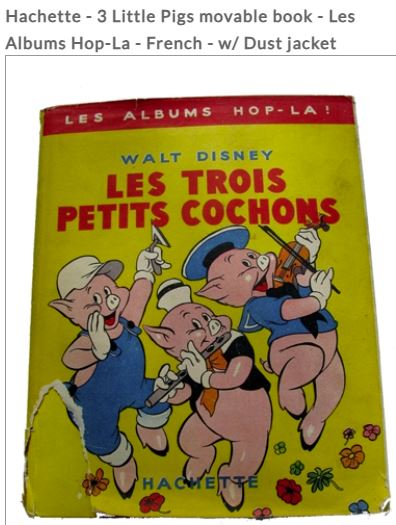 Where is Hachette today? Hachette became L. Hachette et Compagnie, Librairie Hachette, Hachette SA and Hachette Livre after it was acquired by the Lagardère Group in 1981. After buying an Australian publisher, Hachette Australia was created; They expanded to the UK as Hachette UK, and into the United States as Hachette Book Group USA. In 2019, Hachette sold Disney Hachette Presse to Unique Heritage Media.
France References:
1. Wikipedia (French). "Magdeleine du Genestoux." Retrieved from Wikipedia. 2. Hachette Livre. "Mickey et Minnie." Special agreement with Walt Disney. Paris: Librairie Hachette, 1932. Collection Bibliothèque Rose Illustrée. 3. Chronique Disney. "Portrait de Paul Winkler." February 2014. Retrieved from Chronique Disney. 4. The Walt Disney Archives – Disney Legends. Retrieved from The Walt Disney Archives. 5. Reference for Business. "Matra-Hachette S.A. - Company Profile, Information, Business Description, History, Background Information on Matra-Hachette S.A." Retrieved from Reference for Business. 6. Strenæ - Revue de l'AFRELOCE (Association Française de Recherches sur les Livres et Objets Culturels de l’Enfance). Baudry, Julien, and Litaudon, Marie-Pierre. "Hachette between heritage and renewal (1920-1960): how to 'collect' in the face of the challenge of 'transmedia' albums." Retrieved from Strenæ. 8 Wikipedia page on "Inducks," accessed January 9, 2024: Inducks. 9 Wikipedia page on "Le Journal de Mickey," accessed January 9, 2024: Le Journal de Mickey. 10 Wikipedia page of Magdeleine du Genestoux, accessed January 9, 2024: Magdeleine du Genestoux. 11 AbeBooks listing for "Album Hop-la! Mickey et le prince Malalapatte" by Magdeleine du Genestoux, accessed January 9, 2024: 12 Listing for "Mickey et le prince Malalapatte" by Magdeleine du Genestoux on Livre Rare Book, accessed January 9, 2024: Livre Rare Book. `3 Geneanet. "Robert Meunier du Houssoy: Genealogical Profile." Accessed [Date of Access]. Available at: https://gw.geneanet.org/pierfit?lang=fr&n=meunier...
ITALY:
Italian editions were published by Mondadori: “Illustrazioni Sorpresa” Ediziono WALT DISNEY-MONDADORI
Mondadori, celebrated in the Italian publishing world, specializes in crafting Italian editions of international literary works. Known for their skillful translations, they adeptly preserve the essence of original texts while tailoring them for Italian readers. This approach has made Mondadori a key player in bringing global literature to Italy's doorstep. Arnoldo Mondadori Editore, recognized as the largest publishing company in Italy, has a rich and diverse history in the world of publishing. Founded in 1907 in Ostiglia by a young and ambitious 18-year-old, Arnoldo Mondadori, the company marked its beginnings with the publication of the magazine "Luce!" This venture was just the start of Mondadori's illustrious journey in the publishing world. In 1919, seeking new horizons and opportunities, the company moved its headquarters to the vibrant cultural hub of Milan, setting the stage for its future growth and success in the publishing industry.. In 1935, Arnoldo Mondadori successfully negotiated a deal with Walt Disney, leading to a memorable encounter with Walt and Roy Disney at Mondadori's home in Meina. Walt Disney personally signed what was the largest international agreement with an Italian publisher, sealing a monumental partnership with Mondadori. This historic deal firmly positioned Mondadori at the forefront of children's publishing, closely associated with the globally adored Walt Disney creations. Through the agreement, the publishing house began the publication of a children's series based on Disney cartoon characters, which ran until 1988, when the agreement between Mondadori and the Walt Disney Company ended.
Image Belkow shows Italian publisher Arnoldo Mondadori with Walt Disney.in 1961 Image attributed to Archivi Mondadori, CC BY-SA 4. via Wikimedia Commons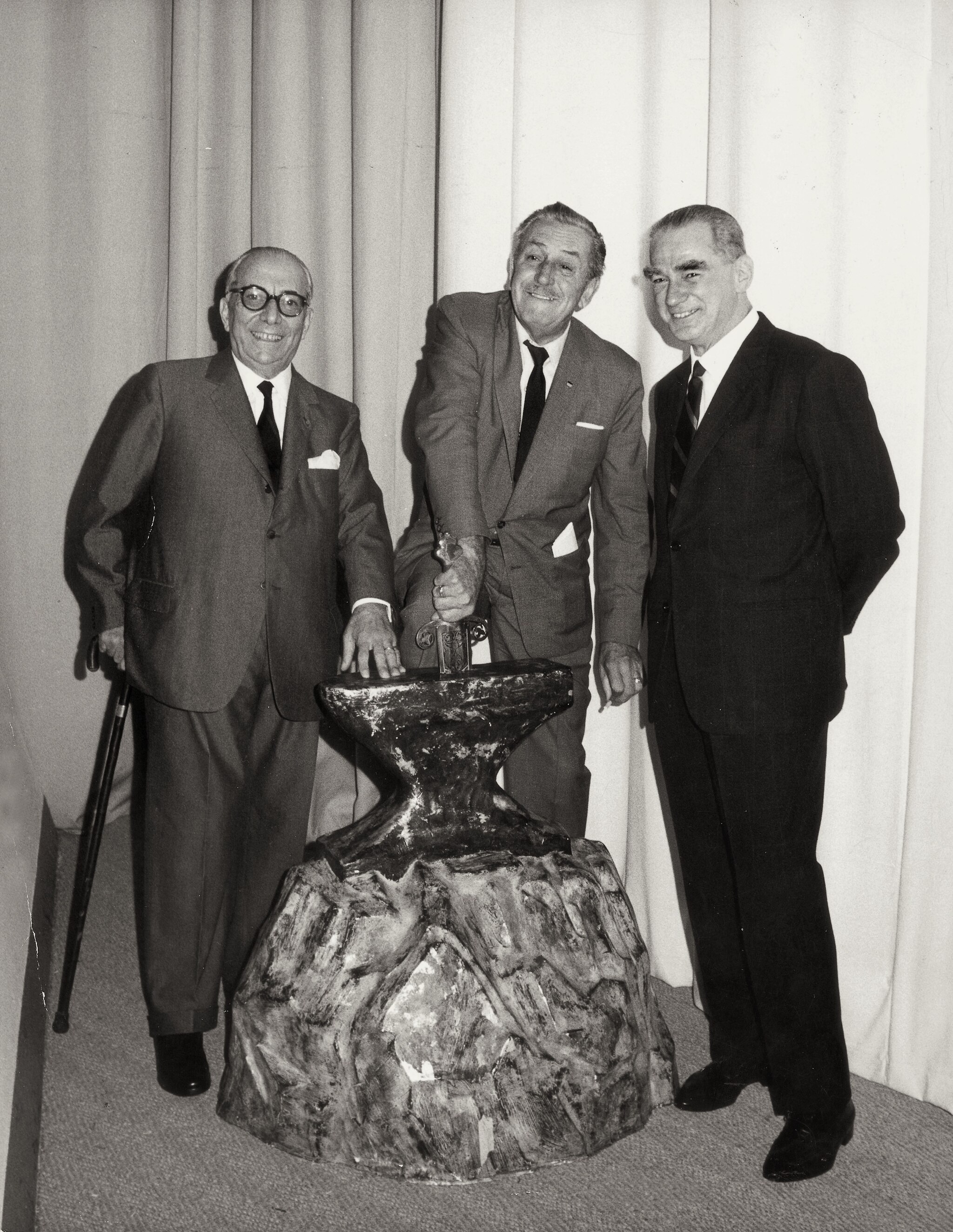
Aftermath: In 1988, Mondadori was then owned by three: Berlusconi's Fininvest, Carlo De Benedetti's CIR and the Formenton family (Arnoldo Mondadori's heir).
It is interesting to note that in 2012 Mondadori published the best seller, Fifty Shades of Grey. Arnoldo Mondadori Editore, the largest publishing company in Italy, is currently controlled by Fininvest, which is owned by Silvio Berlusconi's family. Fininvest has had control over Mondadori since 1991.
A little more history:
Initially, when the pop-up books were first published, the Fascist regime in Italy didn't particularly favor translations of foreign works, but they didn't treat them any differently than other books. All books, including translations, had to meet the same moral and political standards set by the regime. There wasn't a special process for publishing translations.
However, starting in January 1937, the regime made a change. Publishers had to inform the Ministry every time they planned to translate a foreign work.
Mondadori also had a Mickey newspaper
The inaugural issue of "Topolino," an Italian comic series featuring Mickey Mouse, was released on December 31, 1932. In 1938, amidst Mussolini's regime, there was a widespread prohibition on American stories, but Disney stories were a notable exception. This leniency is often attributed to Mussolini's children's fondness for Mickey Mouse, which played a role in postponing the ban on Disney content. Additionally, Mussolini himself held Mondadori in high regard. Consequently, "Topolino" was able to continue publishing Mickey Mouse stories until February 3, 1942, ceasing with issue 564. The onset of World War II in June 1940 saw the regime increasingly rejecting translations, aiming to diminish foreign cultural influence, which ultimately led to the suspension of "Topolino" in 1942.
Mondadori played a key role in fostering the market for translated works in Italy and maintained a significant relationship with the Fascist regime and its cultural department, the MCP (Ministero della Cultura Popolare). Unlike typical communication methods that went through the prefecture, Mondadori frequently engaged directly with the Minister and the Direzione Generale per la Stampa Italiana, the authority responsible for regulating publications in Italy. By 1940, Mondadori's prominence in the publishing sector was further cemented when he was appointed vice president of the Federazione Nazionale Fascista degli Industriali Editori. Following the fall of fascism, Mondadori successfully relaunched Topolino in 1945, which continued in various forms until 1988, marking the end of the collaboration with Disney. The trajectory of Arnoldo Mondadori during the Fascist regime in Italy highlights two significant aspects: the regime's opposition to the influx of translated works as a perceived cultural invasion, and Mondadori's strategic navigation of these restrictions.
Italian versions of the Disney pop-up books: (translated into Italian for Mondadori by Mary Costa) "Topolino Nel Circo" (1935) - "Mickey Mouse in the Circus" "Topolina e l'anatroccolo" (1935) - "Minnie Mouse and the Duckling" "I Nani del Bosco e il Re Nettuno" (1935) - "The Dwarfs of the Forest and King Neptune" "Topolino alla Corte di Re Artù" (1935) - "Mickey Mouse at the Court of King Arthur" Libro Animato di Topolino Mondadori - 1936 ( Italian waddle book )
Rundle, Christopher. "Publishing Translations In Mussolini's Italy: A Case Study of Arnoldo Mondadori." Academia.edu, accessed January 9, 2024, https://www.academia.edu/405452/Publishing_Transl...
NETHERLANDS:
The Dutch editions of Disney's Pop-up series, known as "Pieco boeken," are an intriguing aspect of the history of Disney publications in the Netherlands. These books were translated by Mrs. J. Rienstra Went and published by De Moderne Boekhandel (DMB) copyright by Walt Disney. Enterprises., which translates to The Modern Bookstore. The term "Uitgave" or "Uitgeverij" before DMB
The Dutch newspaper "Leidsch Dagblad" published a review of "Micky Muis in het circus" on 29 November 1938. The reviewer was particularly impressed by the book's pop-up plates, described as "bijzondere opklapbare illustraties" (special fold-out illustrations). The review highlighted the quality and appeal of these illustrations.( Leidsch Dagblad | 29 november 1938 | pagina 10 )
The Modern Bookstore was originally located at Kalverstraat 185 in Amsterdam. In the thirties, The Modern Bookstore moved to Leidsestraat 74.
The Dutch versions were:
Miepsie Muis en het eendje (Minnie Mouse and the duckling (1938) Dutch translated by J. Rienstra-Went. Amst., D.M.B., n.d. (1938), 32p., 3 col. pop-ups Micky Muis in het circus ( Mickey Mouse in the circus) - Amsterdam , D.M.B , 1938 - 32 pp – 3 pop-ups
Micky Muis in het Circus. Door Walt Disney, met illustraties van den Schrijver. Amsterdam, Uitgeverij "D.M.B.", [1938]. The front cover has as a series title: "Serie 'Pieco' boeken,"
As of 01/10/2024, we have not been able to confirm research about De Moderne Boekhandel that actually published "Pieco boeken," if you have information please email is at [email protected]
We did find a photo:
Image below of De Moderne Boekhandel in Amsterdam in 1940 – 2 years after the "Pieco boeken," books were published (wiki commons - public domain)
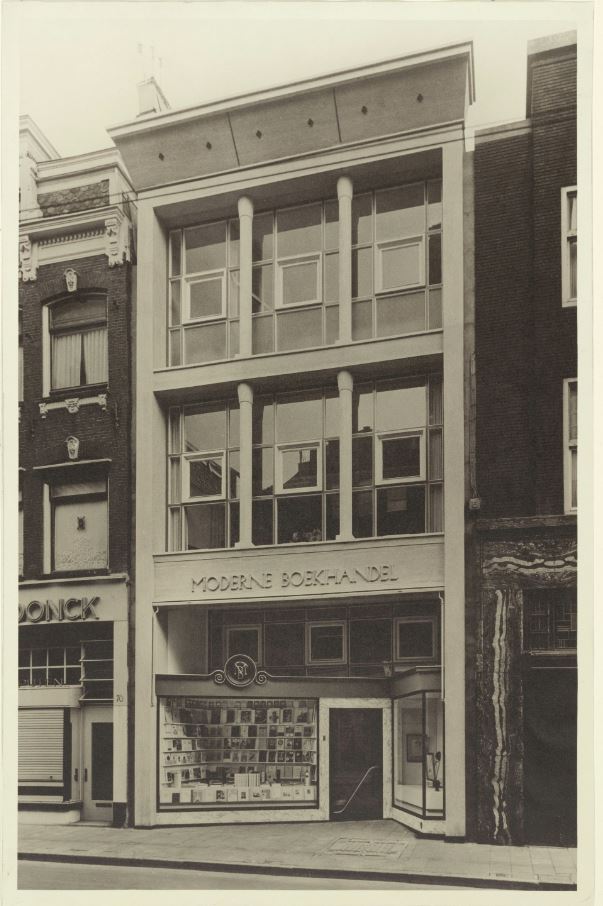
The Modern BookstoreLtd. Bookselling and Publishing CompanyInternational Bookstore(With an Italian Section)General Art DealerAdvertising and Printing ServicesLuxury Papers - PaintingsArtistic Calendars
Illustrated Works - Framing, etc.
Above is their letterhead from a letter dated 1939
Logo from 1930's location: ( Logo kindly provided to us by Antiquarian Bookshop Klikspaan located in Leiden, Netherlands )
|